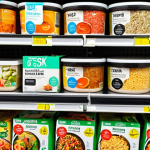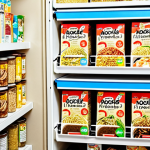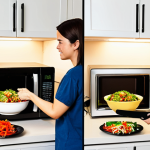We’ve all experienced those days when time is a luxury and the fridge seems to mock us with its emptiness. Instant food, the ultimate convenience, often beckons as a savior, a quick fix for hunger pangs.
But lately, as I’ve personally tried to maintain a balanced diet amidst a whirlwind schedule, I’ve had to seriously question whether these seemingly harmless shortcuts are truly helping or hindering my weight management efforts.
It’s a common dilemma, right? Many of us, myself included, have fallen into the trap of believing instant options can be a diet hack due to their sheer speed.
The landscape of convenience food is evolving, with more ‘health-conscious’ and ‘plant-based’ instant meals hitting the shelves, riding the wave of personalized nutrition trends.
Yet, despite these innovations, the pervasive issues of high sodium, hidden sugars, and a distinct lack of fiber persist in many ultra-processed offerings.
I once tried a pre-packaged ‘diet meal’ that left me feeling strangely bloated and less satisfied than a small apple, completely contradicting its calorie count.
It made me wonder about the true impact beyond just the numbers on the label. As we look ahead, while AI might promise perfectly tailored instant meals, the fundamental challenge remains: can true dietary success and sustainable health genuinely align with a consistent reliance on ready-made convenience?
Let’s definitively uncover the real story.
Deconstructing the Nutritional Mirage of Convenience

We often grab instant food with the best intentions, or sometimes, no intentions at all beyond simple survival. I know I’ve been there, staring at a microwaveable meal, convinced it was my quick ticket to a balanced diet, only to feel utterly bewildered by the aftermath.
It’s like a magic trick where the calories look good on paper, but the actual impact on your body tells a wildly different story. What I’ve personally discovered, often through trial and error, is that the real deception lies in what these meals often lack and what they subtly overload us with.
It’s not just about the calorie count; it’s about the quality of those calories, and how they actually interact with your system. I once meticulously tracked everything I ate for a week, including a few instant meals I swore were ‘healthy,’ and the numbers on sodium and sugar alone were eye-opening, almost alarming.
My body felt sluggish, and my energy levels were all over the place, a stark contrast to how I felt after a similar caloric intake from whole, unprocessed foods.
This experience really solidified my belief that convenience often comes at a hidden nutritional cost that our bodies pay for.
The Sneaky Sodium Overload and Its Bloating Burden
One of the most persistent culprits I’ve identified in my journey with instant foods is the shockingly high sodium content. It’s not just about a salty taste; manufacturers use sodium as a preservative, a flavor enhancer, and a way to extend shelf life, often without us even realizing the sheer volume we’re consuming.
I remember picking up what looked like a benign instant soup, checking the nutrition label, and nearly dropping it when I saw a single serving contained over 50% of my daily recommended sodium intake.
My immediate thought was, “How is this even possible?” This overconsumption leads directly to water retention, making you feel bloated and heavier, which can be incredibly disheartening when you’re trying to manage your weight.
It creates this frustrating cycle where you eat something quick, feel puffy, and then wonder why the scale isn’t moving, despite sticking to calorie limits.
For me, reducing instant food intake and actively seeking out low-sodium options transformed how I felt physically; that persistent bloat, which I just assumed was ‘me,’ actually significantly lessened.
Unmasking Hidden Sugars and the Energy Rollercoaster
Beyond sodium, the insidious presence of hidden sugars in seemingly savory or ‘diet’ instant meals is another major issue I’ve battled. From maltodextrin to corn syrup solids, and countless other aliases, sugar finds its way into almost everything to boost palatability.
I once purchased an instant pasta dish, assuming it was a neutral carb base, only to discover a surprisingly high sugar content. This realization left me completely baffled; why would a savory dish need so much sugar?
What happens is, these sugars cause rapid spikes in your blood glucose, followed by inevitable crashes. I’ve personally experienced this rollercoaster – feeling a quick burst of energy after an instant meal, only to slump into lethargy and intense cravings for more food shortly after.
It’s a vicious cycle that makes sustainable weight management incredibly difficult because you’re constantly battling your own biology, driven by these artificial sugar highs and lows.
This constant battle against cravings, which I now attribute to these hidden sugars, was a significant hurdle in my early weight loss attempts.
| Nutrient | Typical Instant Meal (e.g., Frozen Dinner) | Comparable Homemade Meal (e.g., Chicken & Veggie Stir-fry) |
|---|---|---|
| Calories | 350-600 kcal (often dense, low satiety) | 300-500 kcal (nutrient-dense, high satiety) |
| Sodium | 800-1500mg (often 35-65% DV per serving) | 100-300mg (controlled by you) |
| Added Sugars | 5-25g (often hidden, in sauces/seasonings) | 0-5g (from natural sources like vegetables) |
| Fiber | 2-5g (often low, refined grains) | 8-15g (from whole grains, plentiful vegetables) |
| Protein | 15-30g (can be adequate but from lower quality sources) | 20-40g (from lean, whole sources) |
The Satiety Conundrum: Why Convenience Often Falls Short
It’s a frustrating paradox, isn’t it? You eat a meal, and minutes later, your stomach is rumbling, or you find yourself mindlessly reaching for a snack, despite having just consumed what the label proudly declared was a ‘full meal.’ I’ve experienced this countless times, feeling utterly perplexed after eating an instant lasagna, only to crave something substantial an hour later, like a hearty salad or a piece of fruit.
This isn’t just about willpower; it’s often a direct consequence of the nutritional composition of many instant foods. They might meet the calorie quota, but they fundamentally fail to deliver on the feeling of lasting fullness that genuinely nutritious food provides.
This lack of true satiety is, in my opinion, one of the biggest sabotages to sustainable weight management, leading to overeating and a constant battle against hunger pangs.
Fiber’s Critical Role in Lasting Fullness
One of the primary reasons I believe instant meals often leave us feeling unsatisfied is their distinct lack of dietary fiber. Fiber is the unsung hero of digestive health and satiety; it literally slows down digestion, helps stabilize blood sugar, and provides bulk, making you feel full for longer.
Many instant meals, relying on refined grains and processed ingredients, are stripped of this vital component. I remember a period where I was heavily reliant on instant oatmeal for breakfast, thinking I was making a healthy choice.
While it was quick, I found myself ravenously hungry by mid-morning, a feeling I never experienced when I made steel-cut oats with fruit and nuts. It was a clear demonstration of fiber’s power, or lack thereof.
When your body doesn’t get enough fiber, it simply processes food too quickly, leaving you with that hollow, unsatisfied feeling that screams “eat more!” It’s a key factor often overlooked in the rush for convenience.
The Psychological Satisfaction of a Home-Cooked Meal
Beyond the physical components, there’s a profound psychological aspect to eating that instant foods rarely fulfill. When you prepare a meal yourself, you engage multiple senses: the aroma of cooking onions, the visual appeal of colorful vegetables, the sound of sizzling, the texture of ingredients.
This whole process contributes to a feeling of accomplishment and satisfaction that signals to your brain that you’ve truly eaten. I’ve noticed that even a simple meal I’ve prepared myself, like a basic chicken and vegetable stir-fry, leaves me feeling far more content and less prone to mindless snacking later, compared to a pre-packaged stir-fry that took two minutes to heat.
The ritual of cooking, even for a short time, and the act of sitting down to a meal you’ve assembled, creates a deeper connection to your food. This connection is often completely absent with instant meals, which can lead to a pervasive sense of unfulfillment, making us seek more food, not out of true hunger, but out of a desire for that missing sense of satisfaction.
Navigating the ‘Healthy’ Instant Food Hype and Marketing Maze
The landscape of instant food has undeniably evolved, with brands clamoring to offer “healthier,” “organic,” “plant-based,” and “keto-friendly” options.
It’s almost overwhelming to stand in the grocery aisle and see all these new labels. I, like many others, have been swayed by these claims, eager to find a guilt-free shortcut to a quick meal.
However, my experience has taught me to approach these new offerings with a significant dose of skepticism. Just because a package boasts a buzzword doesn’t automatically translate to a genuinely beneficial product for your weight or overall health.
It’s a marketing maze, designed to appeal to our desires for both convenience and wellness, often without delivering on the latter. I’ve personally been burned by products that sounded like health champions but were, in reality, still ultra-processed with hidden pitfalls.
Decoding Label Claims: What ‘Natural’ and ‘Organic’ Really Mean for Your Waistline
The terms “natural” and “organic” on instant food packaging can be incredibly misleading, especially when you’re focusing on weight management. While “organic” does mean certain farming practices were followed, it doesn’t automatically equate to being low in calories, sugar, or unhealthy fats.
I vividly recall buying an organic instant mac and cheese, thinking it would be a “better” comfort food option. To my dismay, a quick glance at the back label revealed it was just as calorie-dense, if not more so, than its conventional counterpart, and still lacked significant fiber.
Similarly, “natural” can mean almost anything, as it’s a loosely regulated term often used to evoke a sense of wholesomeness without actual nutritional backing.
My personal takeaway is that these terms are often marketing ploys designed to make you feel good about your purchase, rather than genuinely guiding you toward weight-loss friendly choices.
It really hammers home the point that you absolutely have to read the actual nutrition facts, not just the marketing claims on the front.
Plant-Based Doesn’t Always Mean Diet-Friendly: A Closer Look
Another significant trend is the surge in “plant-based” instant meals. As someone who tries to incorporate more plant-rich foods into my diet, I was initially excited by this.
However, I’ve quickly learned that “plant-based” does not inherently mean “healthy” or “weight-loss friendly.” Many plant-based instant burgers, chicken alternatives, and prepared meals are heavily processed, loaded with sodium, refined oils, and artificial ingredients to mimic the taste and texture of meat.
I once tried a popular plant-based frozen “chicken” bowl, confident it was a nutritious choice. After eating it, I felt that familiar post-instant-meal sluggishness, and checking the label later, I discovered it was surprisingly high in saturated fat and sodium for a single serving.
It really opened my eyes to the fact that processing can undermine the natural benefits of plant ingredients. It’s easy to fall into the trap of thinking “it’s plants, so it must be good,” but the reality is that ultra-processed plant-based foods can be just as detrimental to your weight management goals as any other highly processed item.
The Impact on Eating Habits and Long-Term Behavioral Patterns
Relying heavily on instant food does more than just affect our immediate nutritional intake; it subtly, yet profoundly, reshapes our entire relationship with food and eating.
It’s a shift that I’ve noticed creeping into my own life during particularly busy periods. When convenience becomes the default, the fundamental skills and mindful practices associated with nourishing ourselves can begin to erode, almost without us realizing it.
This isn’t just about what we eat, but *how* we eat, and the long-term habits we inadvertently cultivate. I’ve realized that the more I lean on instant solutions, the less intuitive I become about portion sizes, ingredient quality, and even the simple joy of cooking.
This behavioral drift can be a significant, often overlooked, hurdle in sustained weight management.
The Erosion of Cooking Skills and Nutritional Awareness
One of the most concerning long-term effects of a high-instant-food diet, in my opinion, is the gradual erosion of cooking skills and general nutritional awareness.
When you’re constantly reheating or tearing open a package, you simply don’t engage with ingredients, learn how to combine flavors, or understand the basics of food preparation.
I distinctly remember a phase where I was so swamped with work that my kitchen became more of a decorative space than a functional one. I found myself feeling utterly lost when I finally had the time and desire to cook a meal from scratch.
This lack of practical experience also translates into a diminished understanding of what constitutes a truly balanced meal. You stop instinctively knowing that a plate should have a certain amount of protein, vegetables, and whole grains.
This detachment from the food preparation process makes it incredibly difficult to make informed decisions about your diet in the long run.
Mindless Eating and Portion Distortion in the Instant World
Instant foods, by their very nature, often encourage mindless eating. They are designed for speed and minimal effort – eaten on the go, at your desk, or while distracted by screens.
This bypasses the crucial mindful process of recognizing hunger cues, savoring flavors, and understanding true satiety. I’ve personally wolfed down an instant meal in minutes, only to forget I’d even eaten it shortly thereafter.
Furthermore, the pre-portioned nature of instant meals can lead to portion distortion. While some might be genuinely portion-controlled for a single serving, others are deceptively large, or conversely, so small they leave you wanting more, leading to a second portion or additional snacking.
We lose the intuitive sense of what a ‘normal’ portion looks like when everything comes pre-packaged. This disconnect makes it incredibly challenging to manage calorie intake and can inadvertently lead to overeating without conscious awareness, which is a silent killer for weight loss efforts.
Strategic Integration: Making Convenience Work For You, Not Against You
Now, let’s be realistic: in our fast-paced world, completely eliminating instant food might not be feasible for everyone, myself included. There are days when time is simply not on your side, and a quick solution is a necessity.
The key, I’ve learned through my own journey, isn’t outright avoidance, but rather strategic integration. It’s about becoming a discerning consumer, understanding the nuances, and knowing how to make even the most convenient options work *for* your weight management goals, rather than against them.
This involves a more mindful approach to selection and a little bit of creativity in how you prepare and augment these ready-made items. It’s about being empowered, not enslaved, by convenience.
Smart Choices: Reading Labels and Identifying Nutrient Powerhouses
When you absolutely must rely on an instant meal, the power lies in your ability to be a smart shopper. My personal rule of thumb now is to spend an extra 30 seconds reading the nutrition label, especially focusing on key indicators.
I look for items with higher fiber content (ideally 5g or more per serving), moderate sodium (aiming for under 600mg, though this can be tough), and minimal added sugars.
I also prioritize options that clearly state whole grains, lean proteins, and visible vegetables as primary ingredients. For example, I’ve found some instant oatmeal cups that are genuinely just oats with minimal sugar, which I can then augment with fruit.
Or, instant soups that are vegetable-based and lower in sodium. It takes a moment longer, but that small investment of time can make a massive difference to your satiety and overall nutritional intake, preventing that post-meal regret.
The Art of Augmentation: Boosting Instant Meals with Whole Foods
This is where you truly take control and turn a simple instant meal into something much more substantial and nourishing. I often refer to this as “instant meal hacking.” Let’s say I’m heating up a basic instant ramen for a quick lunch – I won’t just eat it as is.
I’ll throw in a handful of fresh spinach, some pre-cooked shredded chicken, and perhaps a soft-boiled egg. Suddenly, a nutrient-poor carb bomb transforms into a protein and fiber-rich meal that actually fills me up and provides sustained energy.
The same goes for frozen meals; I’ll always add a side of steamed broccoli or a simple salad. It’s about using the instant component as a base and then building it up with fresh, whole ingredients you already have on hand.
This strategy drastically improves the nutritional profile, boosts satiety, and makes me feel like I’m still actively participating in my healthy eating goals, even on the busiest days.
Beyond Diet: The Broader Wellness Implications of Instant Food Reliance
While our primary focus here is often on weight management, it’s crucial to understand that a diet heavily reliant on instant food extends its impact far beyond just the numbers on the scale.
My journey has opened my eyes to the holistic nature of health, where everything is interconnected. What we eat affects our energy levels, our mood, our gut health, and even our long-term disease risk.
The convenience food industry, by its very nature, often prioritizes shelf stability and mass appeal over genuine nutritional integrity, leading to a cascade of effects on our overall well-being.
It’s not just about fitting into clothes; it’s about feeling vibrant, strong, and truly healthy from the inside out.
Gut Health and the Microbiome: What Ultra-Processed Foods Do
Perhaps one of the most eye-opening revelations for me, concerning instant foods, has been their profound impact on gut health and our precious microbiome.
Our gut is often called our “second brain,” and a diverse, healthy gut flora is crucial for everything from digestion and nutrient absorption to immune function and even mood regulation.
Ultra-processed instant foods, often low in fiber and high in unhealthy fats, sugars, and artificial additives, can wreak havoc on this delicate ecosystem.
I personally started experiencing more digestive issues and a general feeling of sluggishness when my instant food consumption was at its peak. As I transitioned to a diet richer in whole, unprocessed foods and probiotics, I noticed a dramatic improvement in my digestion, energy, and even my mental clarity.
It became clear to me that feeding my gut beneficial bacteria was just as important as counting calories.
The Environmental and Ethical Footprint of Global Convenience
As I’ve grown more mindful of my food choices for personal health, my awareness has also expanded to the broader implications of the food system, particularly concerning instant foods.
The sheer volume of packaging waste associated with single-serving, ready-to-eat meals is staggering. Think about all those plastic trays, films, and cardboard boxes that are often non-recyclable or end up in landfills.
My own trash bin used to overflow with these items. Beyond waste, there’s the question of the supply chain, the energy required for manufacturing and transportation, and the ethical sourcing of ingredients in such a massive, industrialized system.
While not directly linked to weight management, acknowledging this environmental and ethical footprint is part of a holistic approach to conscious eating.
It influences my decisions to choose less packaged, more locally sourced ingredients whenever possible, adding another layer to my motivation for cooking at home.
Crafting a Sustainable Approach: Small Steps for Big Impact
Ultimately, the goal isn’t to demonize instant food, but rather to find a way to live harmoniously with it in a world that demands speed and efficiency.
My journey has been less about drastic cuts and more about implementing sustainable, realistic strategies that fit into a busy life. It’s about empowering myself with knowledge and simple habits that build up over time, leading to significant, lasting changes in how I feel and how I manage my weight.
I’ve realized that the most impactful changes often come from small, consistent efforts rather than overwhelming overhauls. It’s about being prepared, being mindful, and being kind to yourself through the process.
Meal Prepping as Your Ultimate Convenience Partner
This might sound counterintuitive, but I’ve found that smart meal prepping is the ultimate convenience hack, far superior to any instant meal. Investing even an hour or two on a Sunday can provide me with healthy, portion-controlled meals for several days, drastically reducing my reliance on pre-packaged options during the hectic work week.
I often cook a large batch of lean protein, like grilled chicken or baked salmon, roast a big tray of mixed vegetables, and prepare a pot of quinoa or brown rice.
Then, throughout the week, I can mix and match these components into quick, balanced meals. The feeling of opening my fridge to find ready-to-assemble healthy ingredients is incredibly empowering and removes the decision fatigue that often drives me towards unhealthy instant choices.
It’s like having your own personalized, healthy instant food service, but one you control entirely.
Cultivating Mindfulness: Eating with Intention, Not Just for Speed
Finally, and perhaps most importantly, my biggest shift has been in cultivating mindfulness around eating. In a world that constantly pushes us to rush, taking a few extra moments to simply *be present* with our food can be transformative.
This means slowing down, savoring each bite, paying attention to flavors and textures, and, crucially, listening to my body’s hunger and fullness cues.
I used to eat so fast that I’d often finish a meal before my brain even registered satiety, leading to overeating. Now, I try to put my fork down between bites, engage in conversation (if with others), and truly experience the meal.
Even if I’m eating something simple or semi-instant, this practice helps me recognize when I’m truly satisfied, preventing me from reaching for extra portions or unhealthy snacks later.
It’s a simple practice, but its impact on my eating habits and overall relationship with food has been profound, making weight management feel less like a battle and more like a natural part of my day.
Wrapping Up
As we navigate the demands of modern life, the allure of instant food is undeniable. But as I’ve personally experienced and shared, true wellness isn’t found in shortcuts that compromise our health. It’s about empowering ourselves with knowledge, making conscious choices, and understanding that convenience doesn’t have to come at the expense of our vitality. My hope is that this deep dive encourages you to look beyond the flashy labels and connect more deeply with the food that truly fuels your body and soul. Remember, every mindful choice you make is a step towards a healthier, more vibrant you.
Useful Information to Know
1. Master the Label: Always take a moment to read the nutrition label. Prioritize low sodium (under 600mg), low added sugars (under 5g where possible), and high fiber (5g+) to make healthier instant choices.
2. Augment Your Meals: Don’t eat instant meals as-is. Boost their nutritional value by adding fresh vegetables, lean protein (like a hard-boiled egg or leftover chicken), or healthy fats (avocado, nuts) to enhance satiety and nutrient density.
3. Prioritize Whole Foods: Make whole, unprocessed foods the foundation of your diet. Reserve instant meals for true emergencies, and aim for home-cooked meals with plenty of fruits, vegetables, lean proteins, and whole grains most of the time.
4. Embrace Strategic Meal Prepping: Dedicate a small amount of time each week to meal prep. Having healthy ingredients or pre-made meals ready to go is the ultimate convenience, far surpassing any instant food option in terms of health benefits.
5. Practice Mindful Eating: Slow down and pay attention to your food. Savor the flavors, textures, and aromas. Listen to your body’s hunger and fullness cues to avoid overeating and enhance the psychological satisfaction of your meals.
Key Takeaways
Convenience foods, while seemingly harmless, often present a nutritional mirage, deceptively high in sodium and hidden sugars while lacking essential fiber and nutrients. This can lead to persistent bloating, energy crashes, and a profound lack of satiety, sabotaging weight management efforts and distorting our perception of healthy portions. Relying heavily on them erodes cooking skills and fosters mindless eating habits. However, by becoming a discerning consumer, reading labels meticulously, and strategically augmenting instant meals with whole foods, you can mitigate their negative impacts. Ultimately, understanding the broader implications for gut health and the environment, alongside cultivating mindful eating and embracing meal prep, empowers you to integrate convenience into a truly sustainable and healthy lifestyle.
Frequently Asked Questions (FAQ) 📖
Q: You mentioned the dilemma of instant food and weight management. Can these ‘quick fixes’ truly support a balanced diet for someone with a busy schedule, or are they more of a hindrance?
A: Oh, this hits home! I’ve been there, staring at an empty fridge after a grueling day, just wanting something fast. What I’ve personally found, and it’s been a tough lesson, is that while instant meals seem like the ultimate savior for a jam-packed schedule, they often secretly sabotage weight management.
It’s not just about the calorie count on the label; I mean, I once grabbed this “healthy” looking frozen meal, and sure, the numbers looked okay, but about an hour later, my stomach felt… off, and I was rummaging for snacks again.
It’s that sneaky lack of true satiety, the way they leave you feeling weirdly unsatisfied, that makes you overeat later. It’s like a hidden tax on your diet, you know?
They might solve the immediate hunger, but they rarely nourish you in a way that keeps those cravings at bay long-term.
Q: With so many ‘health-conscious’ and ‘plant-based’ instant options emerging, what should consumers really be scrutinizing beyond the flashy marketing?
A: This is where it gets tricky, because the marketing is so good sometimes, right? They slap on “plant-based” or “diet-friendly,” and you just want to believe it.
But my biggest takeaway from trying out so many of these is that you absolutely have to become a label detective. I’m talking about flipping that package over and heading straight for the sodium and sugar content.
It’s shocking how much is hidden in plain sight! I remember this ‘wholesome’ lentil soup, supposedly a health hero, but it had more sodium than I’d consume in a whole day!
And don’t even get me started on “natural flavors” that often mask added sugars or artificial sweeteners that can trick your body. The lack of fiber is another huge red flag for me – that’s what keeps you feeling full and your digestion happy.
So, yes, the buzzwords are there, but the real story is usually in the ridiculously tiny print on the back.
Q: Looking ahead, if
A: I promises perfectly tailored instant meals, do you genuinely believe convenience food can ever align with sustainable health and long-term dietary success?
A3: That’s the million-dollar question, isn’t it? On one hand, the idea of AI crafting a meal just for my body, avoiding my specific triggers, sounds almost utopian.
But honestly, my gut feeling, after years of navigating this stuff, is that while AI might optimize the nutritional profile of an instant meal, it still won’t fully replicate the benefits of genuinely preparing and consuming whole foods.
There’s a certain mindfulness that comes with cooking, with knowing exactly what’s going into your body, that’s just missing from tearing open a package.
Plus, the sheer process of cooking, even a simple meal, teaches you so much about ingredients, portioning, and satisfying hunger properly. So, while AI could make instant food less bad, I struggle to see it as a true, sustainable path to long-term health success.
It feels like a brilliant bandage, maybe, but not the fundamental lifestyle shift we often need. It’s the difference between being fed and truly nourishing yourself, and for me, that’s a big distinction.
📚 References
Wikipedia Encyclopedia
구글 검색 결과
구글 검색 결과
구글 검색 결과
구글 검색 결과
구글 검색 결과





